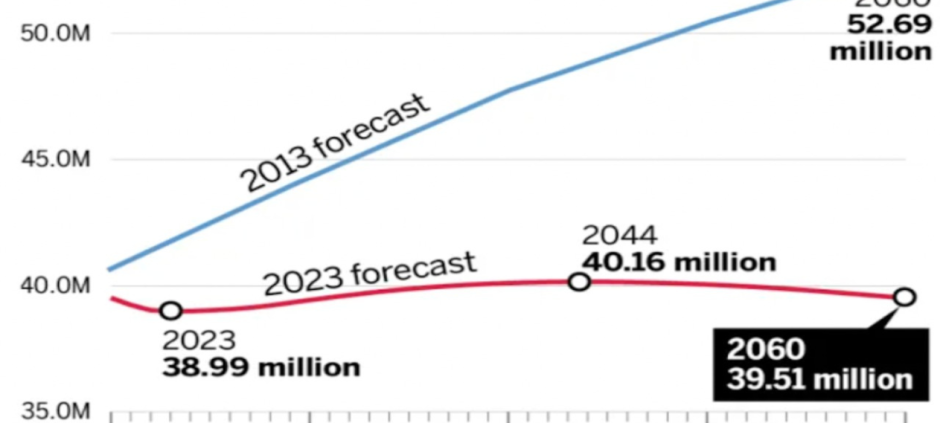California is the most populated state in the United States. It has always attracted people from all over the country and the world. With its beaches, cities, job opportunities, and diverse culture, many people dream of living in California. But in recent years, the state’s population has changed in surprising ways.
In 2025, the California population is estimated to be about 39.5 million. This means the state has added over 100,000 new people in one year. That may seem like a big number, but compared to California’s history, this is slow growth. Still, it is a positive sign after several years of decline. Let’s explore what caused the earlier drop, what’s driving the growth now, and what it means for people living in or moving to California.
Why Did California’s Population Shrink Before?
For a long time, California was a state where the population kept growing. People moved there because of good weather, better jobs, and many chances for success. But something changed around 2020.
Between 2020 and 2022, California lost about 360,000 people. That was the first time in many decades that the population went down instead of up. The main reasons for this were the COVID-19 pandemic, rising housing costs, and natural disasters like wildfires and droughts. Many people found it hard to afford a home in cities like San Francisco or Los Angeles. Some also left to find better jobs or cheaper homes in other states like Texas, Arizona, or Florida.
During the pandemic, many companies allowed people to work from home. This gave people the chance to live in cheaper places while still keeping their jobs. Some families also moved out of crowded cities for safety and space. All these changes caused a large number of people to leave California for the first time in years.
What Is Causing the Growth Now?
After the hard years of the pandemic, things are slowly improving. The California population has started to grow again. In 2023, the state added nearly 200,000 people. In 2024, it added another 108,000. While this growth is smaller than what California used to see, it is a good sign of recovery.
One of the biggest reasons for this new growth is immigration. Many people from other countries continue to move to California. Most of these immigrants now come from Asian countries. They move for jobs, education, and to join family members who already live in the state. Cities like Los Angeles, San Diego, and San Francisco remain popular destinations for new immigrants.
Another reason for growth is natural increase. This means that more babies are being born than people are dying. In 2024, this added over 114,000 people to the population. Even though the birth rate is lower now than it was in past decades, it still helps the population grow slowly.
A third reason is that fewer people are leaving the state compared to the past few years. During the pandemic, many people moved out of California. But now, some of those people are returning. Others are choosing to stay because job markets are better, and extreme weather in other states makes California more attractive again.
Which Cities Are Growing the Fastest?
Not all parts of California are growing at the same pace. Some areas are seeing more people move in than others. Inland cities like Bakersfield and San Diego are seeing the fastest growth. Bakersfield grew by about 1.2 percent in 2024, while San Diego grew by 1 percent. These cities offer more affordable housing and more space than crowded coastal cities.
Los Angeles also grew in 2024, but only by 0.4 percent. This is a small increase for such a large city. Some cities in Northern California, like San Francisco and San José, actually saw small population drops. These areas are still struggling with high home prices and a lack of affordable places to live. Anaheim also lost some people during the same period.
So, while the state is growing, much of that growth is happening away from the coast. Inland and suburban areas are becoming more popular because people can afford to live there more easily.
What About Housing in California?
Housing remains one of the biggest problems in California. There are not enough homes for everyone who wants to live there. This is one of the main reasons why people left the state in the first place. Even with more people coming back, many still struggle to find affordable housing.
In 2024, the number of homes in California grew by just 0.84 percent. That is a small increase compared to how many people the state needs to house. However, there is one bright spot. Accessory Dwelling Units, or ADUs, are becoming more common. These are small homes built on the same land as a bigger home, like a backyard cottage. In 2024, one in every five new homes built was an ADU.
ADUs help add housing in crowded areas without building large apartment complexes. They are growing by over 10 percent each year. While they won’t solve the housing crisis on their own, they are a helpful step in the right direction.
Experts say California still has a long way to go to fix its housing problems. After the housing crash in 2008, many builders stopped building homes. It was hard to get loans, and fewer homes were built for many years. Now, the state is trying to catch up, but the demand is still much higher than the supply.
Who Makes Up California’s Population?
California is one of the most diverse places in the United States. People from many races, ethnic groups, and cultures live there. This diversity shapes the way people live, work, and learn in the state.
In 2025, about 39 percent of people in California are Latino or Hispanic. About 34 percent are White and not Hispanic. Asians make up about 15 percent of the population, and Black or African American people make up about 5.5 percent. Around 6.5 percent of people identify as multiracial or as part of another group.
This mix of cultures is a big part of what makes California unique. It affects the food, language, schools, and even politics in the state.
What Challenges Come with Population Growth?
Even though growth is a good sign, it also brings challenges. As more people live in California, the demand for housing, water, energy, schools, and hospitals grows too.
Traffic is already a big problem in many California cities. More people will likely make it worse unless the state invests in public transportation and better roads. The environment also faces pressure. California already deals with droughts, wildfires, and pollution. More people mean more stress on natural resources.
Schools and hospitals also need support. More children need education, and more families need access to doctors and healthcare. If the state doesn’t plan well, these services may not keep up with demand.
What Does the Future Hold for California?
Experts believe that if current trends continue, California could reach 40 million people within the next few years. But this growth depends on important factors. The state needs to build more affordable housing. It must also keep creating good jobs and handle problems like wildfires and water shortages.
The small increase in the California population shows that the state is slowly recovering from past challenges. But recovery is not enough. Real improvement will come only if the state makes smart choices now to support its people in the future.
California’s future depends on how it handles today’s problems. If it can solve its housing shortage, reduce pollution, and improve services, then it can become a place where more people want to stay and grow.
In conclusion, the California population in 2025 is growing again, though slowly. This growth, after years of decline, shows signs of recovery. People are returning, immigrants are arriving, and more babies are being born than people are dying. But the state still faces serious challenges, especially in housing, transportation, and the environment. By learning from the past and planning wisely, California has the chance to grow in a way that benefits everyone.











